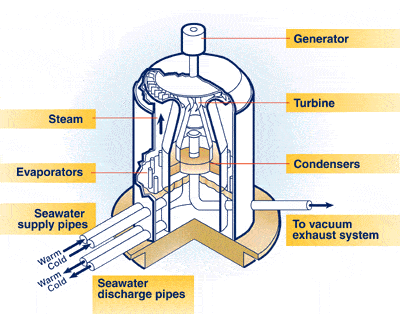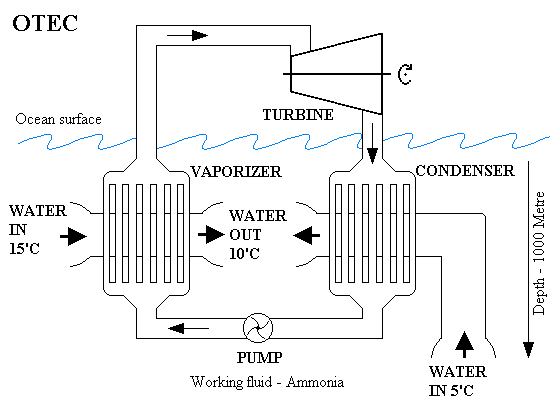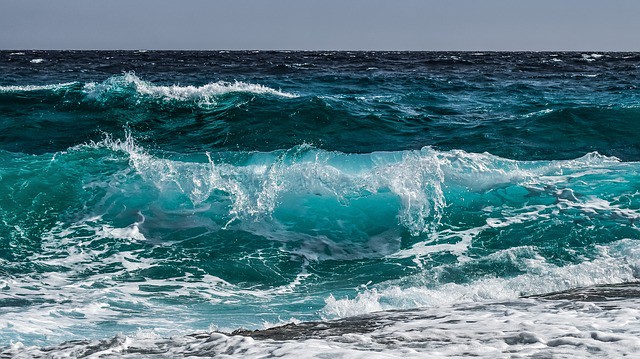In a world where we almost cannot survive without electricity, the need for more supply of energy grows with each passing day. The problem which arises is that most of our nations produce energy from the traditional burning of fossil fuels. By looking at the advantages and disadvantages of ocean thermal energy, we might change this view.
Alternative methods of clean energy such as ocean thermal energy are available to us. But most of our nations barely utilize it. Water is a source of life and without it, we would not survive. Most of us may be aware that about 70 percent of water covers the earth’s surface.
It turns out that more than 90 percent of that water is ocean bodies. This enables various forms of energy production such as ocean thermal energy, tidal energy, wave energy to name a few. But now, we focus only on one renewable energy that is ocean thermal energy and learn how it is different from the other forms of energy produced by oceans.
However, understanding the power of renewable energy in a single article is not a possible thing. Author Godfrey Boyle (Writer and Editor) clearly explains the power of renewable energy and its influence in the future in his book at Amazon.
The book contains lots of illustrations and diagrams to make the material easier to understand. Moderate understanding of math needed to do the calculations, but if all you’re looking for is a review of alternative energy and its place in the world, this will be great for you.
Ok. Now lets come to the discussion of Ocean thermal energy in specific.
Oceans surround many of our countries, and these provide an abundant source of tapping this form of energy. But, in order to benefit from such green energy, it is crucial for us to understand the advantages and disadvantages of ocean thermal energy.
These will help us understand why ocean thermal energy is not widely used despite most of our countries having a coastal region. Also, we may learn how this form of energy could be of importance to us and our future generations.
If we abandoned traditional methods like fossil fuels and started to use this clean energy for electricity generation then we, in my opinion, would have more benefits than limits.
But first, let us understand what ocean thermal energy is and how plants utilize this energy.
Understanding Ocean Thermal Energy
In the oceans, water temperatures may differ according to height differences and regions. As the sun shines on the surface water, it transfers heat energy to this water. Thus, surface water becomes much warmer than deep waters. This mainly occurs in tropical regions.
Ocean thermal energy conversion (OTEC) uses this phenomenon to generate electrical power through the temperature difference in the ocean bodies between the surface waters and deep waters. Thus we learn that this technology uses thermal gradients to generate electricity.

Image: http://www.daviddarling.info/encyclopedia/O/AE_ocean_thermal_energy_conversion.html
Asking how the energy is used to generate electrical power can be very interesting for us to learn. Here is information detailed on the conversion process.
Studies show that the ocean’s water can store about 1000 times more heat as compared to the atmosphere. The heat is then distributed in a belt-like conveyor movement by the action of temperature difference, wind and the rotation of the earth.
An OTEC plant generates power without the need for burning fossil fuels. We learn that this system only requires the temperature difference in the ocean water to produce power. Ocean thermal electric conversion takes in warm water and uses it to boil propene. We should note that it does not burn the propene, instead only raise its temperatures to enable it to boil.

Image: https://commons.wikimedia.org/wiki/Category:Ocean_thermal_energy#/media/File:OTEC_diagram.gif
This boiling propene then runs the turbine which in turn generates electricity. This generated power gets transported through an underwater cable to land. The cold deep water gets pumped up by a pipe and used to cool and condense the boiling propene. The propene goes back to boiling, and the cycle renews.
Now that we know the process of generating electricity from ocean thermal energy, we may now understand the pros and cons of producing this form of energy.
Advantages and Disadvantages of Ocean Thermal Energy
Looking into the benefits or limitations of OTEC will help us to deduce whether this form of energy production is economical or not.
Advantages of Ocean Thermal Energy
- Renewable Energy
OTEC is one of the various green energy sources gaining a presence in some of our countries. Oceans are in full availability with almost zero chances of ever running out. Also, the difference in temperatures in the ocean bodies will almost always occur. This makes the production of ocean thermal energy renewable. Hence, we can generate electricity for a lifetime without this source depleting.
There is a high probability of forbidden future use of fossil fuels in most nations. Fossil fuels are depleting at a rapid rate following the high demand for energy supply. But, we need to understand that fossil fuels have hazardous impacts on us and our environment.
For this reason, many of our nation’s interest is to produce electricity from a source which is green. Ocean thermal energy falls in this category.
- Reliable
Although we may get tempted to become excited over the production of renewable energy, some of the production methods may prove to be unreliable. Electrical generation methods, such as solar and wind power, can be inaccurate due to weather variations.
Ocean thermal energy is thus considered a reliable source of energy due to having minimal variations. Thus, firms that provide ocean thermal energy do not have to seek alternative methods of electricity generation. This is because this form of energy generation may not have “low seasons” unlike solar and wind power which may face low production in a time of no sunshine or wind.
- Clean Energy
We may notice that nowadays, many countries are trying to go green. This does not only apply to tree-planting but also to electrical power production. Clean energy production is a target of the future for many of our countries. Ocean thermal energy is one of the many forms of clean energy.
The floating OTEC plants do not require natural gas, coal or any other fossil fuels to run and hence the generation of electricity is through the water. This places OTEC as one of the electricity production technologies that have potential in the future.
- Low Maintenance
Many of us would want to purchase something that would last us for long with little or no maintenance. Ocean thermal energy plants have such qualities. The machinery used, once installed, requires low maintenance.
Also, the staff needed to run and operate these floating OTEC plants is minimal and hence cost-effective.
- Independent of Weather
We can learn that ocean thermal energy power plants are located in the water. Only the top part appears like it is floating on the water. Thus, the weather does not significantly affect these plants and known to be all-weather and hurricane-proof.
Also, since the plant relies on the temperature of water between the surface and deep waters, we can hence consider it as an independent of weather which may affect other renewable energy production plants such as solar and wind power.
- Environmental-friendly
The ocean thermal energy plants are usually located in the sea and away from human settlement. This ensures that there is no interaction between the dense human population on land and the energy plant. Also, since it does not require any use of fossil fuels for production, it promotes the status of the environment and especially the atmosphere. We can hence get fresher air when we turn to ocean thermal energy generation.
As we learned earlier on that the plant takes in cold and warm water, we may also discover that this can be an advantage. The pump may intake the deep cold water alongside with nutrients that are located in the deep parts of the ocean. The release of these nutrients in the surface water may then enrich this water and provide fishing grounds.
Now, let’s look at some of the drawbacks of ocean thermal energy and determine why it may not be economical to engage in this form of energy production.
Disadvantages of Ocean Thermal Energy
- High Initial Cost
We can learn that the cost to purchase and install the necessary equipment for harnessing OTEC is high. Since we are at a time when the standards of living are high in many of our countries, establishing ocean thermal energy plants may be limited to some of our nations.
Also, it may require a large number of professionals to set up the plant. They also need to cater to these services, which are relatively expensive, in the budget planning.
- Locality of Production
Just like other ocean energy generation methods, we learn that there are various suitable places for this energy harnessing. This is a limiting factor to some countries with a coastal line or even landlocked nations.
In ocean thermal energy, the concept takes advantage of the temperature gradient and choosing the most suitable area in the ocean is paramount for the best results. But, from research, the hot and cold waters provide a temperature gradient that occurs mainly in tropical regions. Thus many of our nations that are not within this locality may not benefit from this form of energy.
- Small Temperature Difference
The difference in temperatures between the surface waters and the deep waters may be small. Hence, this may produce electric energy with low efficiency.
Also, can be very costly to small electricity enterprises that rely on this form of energy production. At the same time, some of our electricity providers using this form of energy generation may have to get a “plan B.” This will be a backup power generation method so that they continue to supply the electricity in times of these low efficiency.
- Harmful Effects on Marine Life
The ocean thermal energy plant has pipes running down all the way to the deepest parts of the ocean. Thus we can see that these pipes may interfere with marine life. Also, small water animals may get drawn by force to the pipes through the pumping action of the water.
Thus, we learn that despite the plant being environmental-friendly to human population and land, it may not extend the same to the water ecosystem.
- Interfere with navigation
The ocean thermal plant may appear as though it is floating on the water, yet it has an elongated and massive construction under water. Large ships may experience difficulties in navigation with the floating body round.
In most cases, we learn that some locations, where there may be ocean thermal energy plants, can also be a passageway to these ships. Hence blocking their route or forcing the ships to look for other routes.
- Large size turbines with expensive liquid
The ocean thermal energy plant may require large sizes of turbines. We should learn that these plants use large turbines because of the low pressure in the boiling propene. The limitation comes in when the prices of turbines may be high and unaffordable.
Also, the cost of the propene is another thing that we should consider. This is the liquid used in the energy plant and may be expensive to acquire for some of our electricity generating companies.
Conclusion
Overall, ocean thermal energy is one of the infant energy generation techniques that are coming up today. In our future world, most of our nations may establish a permanent ban on fossil fuels. This ban may rise due to a possible depletion of the fuels or the harmful effects that these fossil fuels have on our atmosphere.
So what would we do if we experienced such a decree now?
The good news is that there is an abundance of green energy resources. In ocean thermal energy, it gets better since the ocean water is plentiful. But, after analyzing the advantages and disadvantages of this form of energy, we can deduce whether it is of benefit to the economy or whether its drawbacks would limit its establishment in some of our countries.
But, in my opinion, ocean thermal energy has a high potential for future development and establishment. In today’s society, people are welcoming green energy, and even some of our countries have targets to hit in the upcoming years on going green.
Since we cannot rely on solar and wind energy alone, investment in alternative methods will take place. But either way, studies claim that ocean thermal energy produces enough electricity for commercial purposes which can help a country’s economic growth.




